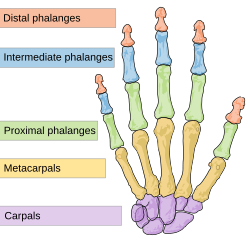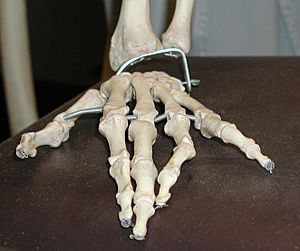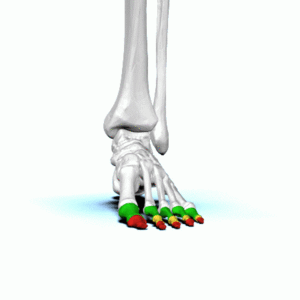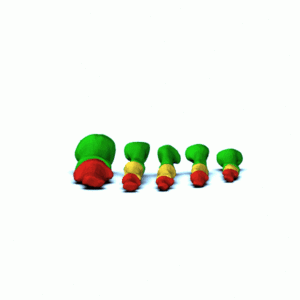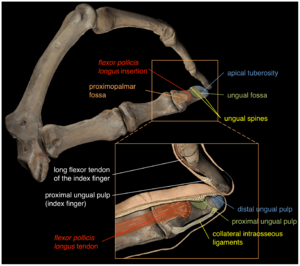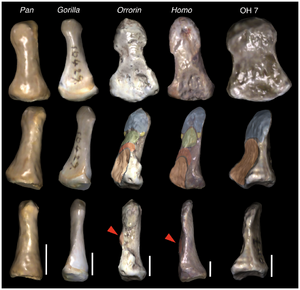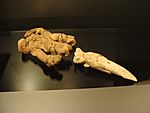Phalanx bone facts for kids
| Bone: Phalanx bone | ||
|---|---|---|
| Bones of the hand | ||
| Bones of the foot | ||
| Latin | phalanx pl. phalanges |
|
| Articulations | Metacarpophalangeal, metatarsophalangeal, interphalangeal | |
The phalanges (say: fuh-LAN-jeez) are the bones that make up your fingers and toes. You have these bones in your hands and feet. Most animals with a backbone, like humans, have phalanges.
In people, your thumbs and big toes have two phalanges. All your other fingers and toes have three phalanges. These bones are known as long bones because they are longer than they are wide.
Contents
What are Phalanges?
Toe bones or phalanges of the foot. Notice the big toe has no middle phalanx.
Sometimes the smallest toe also has only two bones (not shown). Distal phalanges of the foot Middle phalanges of the foot
Your body has 56 phalanges in total. There are 14 phalanges in each hand and 14 in each foot. Each finger and toe has three phalanges, except for your thumb and big toe. These two digits only have two phalanges. Sometimes, the middle and end phalanges of the smallest toes can be joined together.
The phalanges in your hand are often called finger bones. The phalanges in your foot are usually shorter and flatter than those in your hand. This is especially true for the bones closest to your body.
Naming the Phalanges
Each phalanx is named based on its position. They can be proximal, middle, or distal. This also depends on which finger or toe they belong to.
- The proximal phalanges are the ones closest to your hand or foot. In your hand, the bumpy ends of these bones are your knuckles. These bones connect to the metacarpal bones in your hand or the metatarsal bones in your foot.
- The middle phalanges are in the middle. They are usually also medium-sized. Your thumb and big toe do not have a middle phalanx.
- The distal phalanges are the bones at the very tips of your fingers or toes.
All these phalanges connect to each other through joints.
Bone Parts
Each phalanx has a main part called the body and two ends.
- The body is flat on the sides. It is curved inward on the palm side and curved outward on the back of the hand side.
- The proximal ends are the ends closest to your body. They have oval-shaped surfaces that connect to other bones.
- The distal ends are the ends furthest from your body. They are smaller than the proximal ends. Each distal end has two rounded bumps called condyles (knuckles) with a shallow groove between them.
Distal Phalanx Details
In your hand, the distal phalanges are flat on the palm side. They have a rough, raised area that supports the soft pads of your fingertips. The wide, flat parts at the tips are called apical tufts. They help support your fingertip pads and nails.
In your foot, the distal phalanges are flat on the top side. They are widest at the base and get narrower towards the tip. The wide base connects to the middle phalanx. The expanded tip supports your toenail and the end of your toe.
How Phalanges Grow
Scientists often use a "phalangeal formula" to describe the number of phalanges in animals. This formula lists the number of phalanges in each digit, starting from the thumb or big toe. For example, humans have a 2-3-3-3-3 formula for the hand. This means the thumb has two phalanges, and the other four fingers each have three.
The distal phalanges in your hand are the first bones to harden (ossify) during development.
What Phalanges Do
The distal phalanges are very important. In animals with hooves, they support and shape the nails and claws. In primates, like humans, these are called ungual phalanges. They help us grip things and use our fingertips.
History of the Word
Etymology
The word "phalanx" comes from an ancient Greek army formation. In this formation, soldiers stood side by side in many rows, just like your fingers or toes are arranged.
Phalanges in Animals
Most land mammals, including humans, have a 2-3-3-3-3 formula for both their hands (or paws) and feet.
Primates
The shape of the distal phalanges in human thumbs is perfect for a precise grip. This means we can pick up small objects with our fingertips. This ability has been linked to when early humans started making stone tools.
In Neanderthals, a type of ancient human, the tips of their phalanges were larger and stronger than in modern humans.
Whales
Whales have a special feature called hyperphalangy. This means they have more phalanges per digit than most mammals. For example, a humpback whale might have a formula like 0/2/7/7/3. This extra number of bones helps them move their flippers in the water.
Other Mammals
In ungulates (hoofed mammals) like horses or giraffes, their front limbs are built for speed. Their lower leg bones and phalanges are very long. This helps them run fast. The giraffe, for example, has large end phalanges and fused bones in its "hand" to handle the stress of running.
Sloths spend their lives hanging upside-down from branches. Their third and fourth digits are very specialized for this. They have short proximal phalanges and much longer terminal phalanges. This makes it hard for them to walk on the ground.
-
Distal phalanges of a Masai giraffe
-
Terminal phalanx of a Scelidotherium ground sloth
Images for kids
See also
 In Spanish: Falange (hueso) para niños
In Spanish: Falange (hueso) para niños


